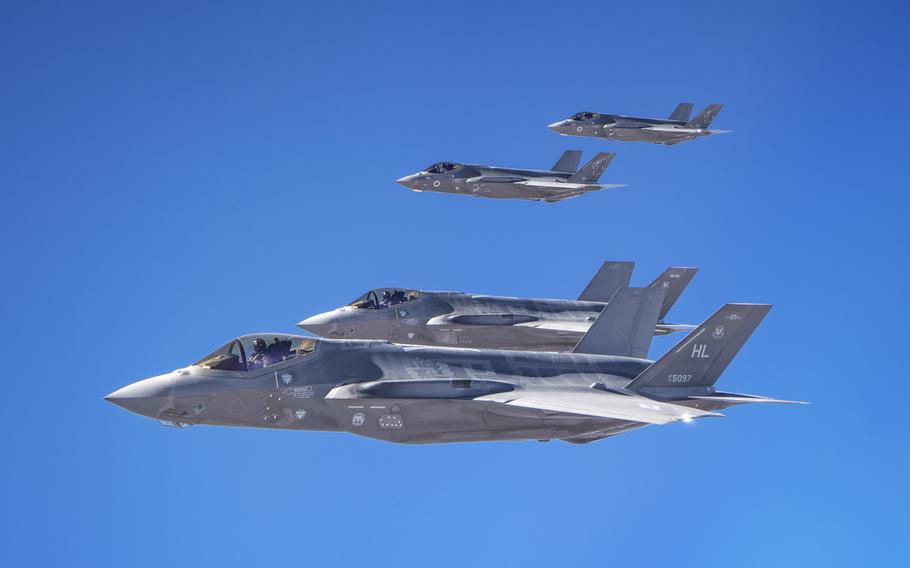
Air Force F-35A Lightning IIs and Israeli Air Force F-35I Adirs fly in formation during exercise Enduring Lightning III over Israel in October 2020. (Duncan Bevan/U.S. Air Force)
WASHINGTON — The Pentagon isn’t keeping track of tens of thousands of spare parts for F-35 fighter jets worth millions of dollars because it was unclear who is responsible for doing it, according to a congressional audit released Tuesday.
The U.S. military and many nations such as Israel and Japan have been flying the F-35 Lightning II for several years, which creates a need for various parts to be kept at locations in many countries around the globe. The Pentagon maintains a global pool of spare parts that ally countries can tap into when needed. However, there is no Defense Department system to monitor those inventories and keep track of the parts, according to the Government Accountability Office report.
The main reason that no accountability system exists for spare parts in the global pool is because it was never expected the U.S. military would own parts for F-35s purchased by other countries.
“[Defense Department] initially did not intend to own the F-35 assets, which include the global spares pool and support equipment, special tooling and special test equipment,” the 35-page GAO report states. “Because DOD did not develop a plan to address this … the prime contractors continued to maintain accountability.”
The prime contractors are the F-35’s manufacturer, Lockheed Martin, and the company that produces its engines, Pratt & Whitney.
Over time, the inventory process became murkier because the spare parts in the global pool ended up in different inventory systems at Lockheed Martin and Pratt & Whitney — and were stored at dozens of locations that were not owned by the U.S. government or either company, according to the report.
The result is a cloudy picture of how many spare parts are in the pool, how many have been lost or misplaced, what was paid for them and how much they’re worth, the report states.
“The F-35 Joint Program Office was unable to provide the cost, total quantity and locations of spare parts in the global spares pool, and continues to rely on the prime contractors’ records for this information,” according to the GAO report.
The Joint Program Office, which manages all aspects of the F-35 program, has been working on the problem. It has spent $12 million in the past three years on efforts to inventory the global pool. That effort was still ongoing in December.
The report includes four recommendations that could help the Pentagon keep better track of the parts in the global pool — create a single “contract” to track and categorize all the parts, allow contractors to report losses in the interim, make certain Pentagon part-tracking guidance is clear and unambiguous, and specify what should be done with extra, obsolete and unusable spare parts in the pool.
The Defense Department agreed with all four recommendations, but noted one of the contractors is being uncooperative. The “vendor” was not identified.
“The [F-35] JPO is currently assessing next steps to address spares pool accountability,” the Pentagon said in a statement.
The Defense Department estimates the F-35 will cost $1.7 trillion to operate, maintain and support through the end of its life cycle in the late 2080s. It’s the most expensive weapon in U.S. military history and variants of the fighter are being flown by the Air Force, Navy and Marine Corps.
Lockheed Martin has so far produced and delivered more than 900 of the fifth-generation fighter jets to the U.S. military and allied governments, including Italy, Australia, Denmark, the Netherlands, Norway, South Korea and Britain. Turkey and the United Arab Emirates initially ordered dozens of the planes, but the sales ultimately fell through for different reasons.